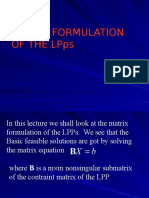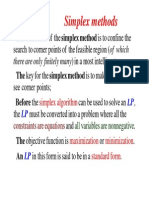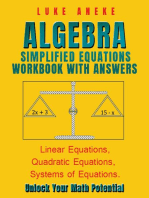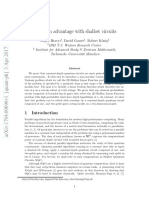Simplex Algorithm
Uploaded by
Kamal GaneriwalaSimplex Algorithm
Uploaded by
Kamal GaneriwalaAlgebraic Solution of LPPs - Simplex
Method
To solve an LPP algebraically, we first put it
in the standard form. This means all
decision variables are nonnegative and all
constraints (other than the nonnegativity
restrictions) are equations with nonnegative
RHS.
Converting inequalities into equations
2 1
3 2 x x z + =
Subject to
0 ,
6 2 3
6 3
2 1
2 1
2 1
>
s +
s +
x x
x x
x x
Maximize
Consider the LPP
We make the inequalities into equations by
adding to each inequality a slack variable
(which is nonnegative). Thus the given LPP
can be written in the equivalent form
2 1
3 2 x x z + =
Subject to
0 , , ,
6 2 3
6 3
2 1 2 1
2 2 1
1 2 1
>
= + +
= + +
s s x x
s x x
s x x
are slack variables.
2 1
, s s
Maximize
Thus we seem to have complicated the
problem by introducing two more variables;
but then we shall see that this is easier to
solve. This is one of the beauties in
mathematical problem solving.
The inequalities are made into equations
by subtracting from each such inequality a
surplus (non-negative) variable.
Thus the LPP
2 1
3 2 x x z + =
Subject to
0 ,
2 2 3
6 3
2 1
2 1
2 1
>
> +
s +
x x
x x
x x
Maximize
is equivalent to the LPP
2 1
3 2 x x z + =
Subject to
0 , , ,
2 2 3
6 3
2 1 2 1
2 2 1
1 2 1
>
= +
= + +
s s x x
s x x
s x x
is a slack variable; is a surplus variable.
2
s
1
s
Maximize
If in a constraint, the RHS constant is
negative, we make it positive by
multiplying the constraint by -1.
Thus the LPP
2 1
3 2 x x z + =
Subject to
0 ,
2 2 3
6 3
2 1
2 1
2 1
>
> +
s +
x x
x x
x x
Maximize
is equivalent to the LPP
2 1
3 2 x x z + =
Subject to
1 2
1 2
1 2
3 6
3 2 2
, 0
x x
x x
x x
+ s
s
>
Maximize
Its standard form is the LPP
2 1
3 2 x x z + =
Subject to
0 , , ,
2 2 3
6 3
2 1 2 1
2 2 1
1 2 1
>
= +
= + +
s s x x
s x x
s x x
Maximize
are slack variables.
2 1
, s s
Dealing with unrestricted variables
If, in an LPP, a decision variable x
i
is
unrestricted (in sign) i.e. it can take positive
as well as negative values, then we can, by
writing
i i i
x x x
+
=
,
i i
x x
+
are (defined below and are) nonnegative, make
the LPP into an equivalent LPP where all the
decision variables are 0.
Note:
| |
;
2
i i
i
x x
x
+
+
=
if 0 and otherwise
i i i i
x x x x
+
= >
where
| |
2
i i
i
x x
x
=
Thus the LPP
Maximize
2 1
3x x z + =
Subject to
1 2
1 2
1 2
2
4
unrestricted, 0
x x
x x
x x
+ s
+ s
>
is equivalent to the LPP
2 1 1
3x x x z + =
+
Subject to
1 1 2 1
1 1 2 2
1 1 2 1 2
2
4
, , , , 0
x x x s
x x x s
x x x s s
+
+
+
+ + =
+ + + =
>
Maximize
Basic variables, Basic feasible Solutions
Consider an LPP (in standard form) with m
constraints and n decision variables. We
assume m n. We choose n m variables and
set them equal to zero. Thus we will be left
with a system of m equations in m variables.
If this mm square system has a unique
solution, this solution is called a basic
solution. If further if it is feasible, it is called
a Basic Feasible Solution (BFS).
The n-m variables set to zero are called
nonbasic and the m variables which we are
solving for are known as basic variables.
Thus a basic solution is of the form
x = (x
1
, x
2
, , x
n
) where n-m components
are zero and the remaining m components
form the unique solution of the square
system (formed by the m constraint
equations).
Note that we may have a maximum of
basic solutions.
n
m
| |
|
\ .
Consider the LPP:
Maximize
2 1
3 2 x x z + =
Subject to
0 ,
6 2 3
6 3
2 1
2 1
2 1
>
s +
s +
x x
x x
x x
C
This is equivalent to the LPP (in standard form)
Maximize
2 1
3 2 x x z + =
Subject to
0 , , ,
6 2 3
6 3
2 1 2 1
2 2 1
1 2 1
>
= + +
= + +
s s x x
s x x
s x x
are slack variables.
2 1
, s s
Nonbasic
(zero)
variables
Basic
variables
Basic
solution
Assoc
-iated
corner
point
Feasible?
Object-
ive value,
z
(0,0,6,6) O Yes 0
(0,2,0,2) B Yes 6
(0,3,-3,0) E No -
(6,0,0, -12) D No -
(2,0,4,0) A Yes 4
C Yes
48/7
Optimal
) 0 , 0 ,
7
12
,
7
6
(
) , , , (
2 1 2 1
s s x x
) , (
2 1
x x
) , (
1 1
s x
) , (
2 1
s x
) , (
1 2
s x
) , (
2 2
s x
) , (
2 1
s s ) , (
2 1
x x
) , (
1 1
s x
) , (
2 1
s x
) , (
1 2
s x
) , (
2 2
s x
) , (
2 1
s s
Graphical solution of the above LPP
x1
x2
O A
D
B
E
C
(2,0)
(6,0)
(0,2)
(0,3)
(6/7, 12/7)
Optimal point
(0,0)
Thus every Basic Feasible Solution
corresponds to a corner(=vertex) of the set
S
F
of all feasible solutions.
S
F
Consider the LPP:
Maximize
2 1
3x x z + =
Subject to
1 2
1 2
1 2
unrestricted
2
4
, 0
x x
x x
x x
+ s
+ s
>
Question 6 (Problem set 3.2A Page 79)
This is equivalent to the LPP(in standard form)
Maximize
2 1 1
3x x x z + =
+
Subject to
0 , , , ,
4
2
2 1 2 1 1
2 2 1 1
1 2 1 1
>
= + + +
= + +
+
+
+
s s x x x
s x x x
s x x x
Nonbasic
(zero)
variables
Basic
variables
Basic
solution
Assoc-
iated
corner
point
Feasible? Objective
value, z
(0,0,0,2,4) O Yes 0
(0,0,2,0,2) B Yes 6
(0,0,4,-2,0) E No -
(0,-2,0,0,6) - No -
(0,4,0,6,0) D Yes -4
(0,1,3,0,0) C Yes 8
) , , , , (
2 1 2 1 1
s s x x x
+
) , , (
1 1 1
s x x
+
) , , (
1 2 1
s x x
+
) , , (
2 1 1
x x x
+
) , , (
2 1 1
s x x
+
) , , (
2 2 1
s x x
+
) , , (
2 1 1
s s x
+
) , (
2 1
s s
) , (
2 1
x x
) , (
1 1
s x
) , (
2 1
s x
) , (
1 2
s x
) , (
2 2
s x
Optimal value
Nonbasic
(zero)
variables
Basic
variables
Basic
solution
Associ-
ated
corner
point
Feasible
?
Objective
value, z
(2,0,0,0,6) A Yes 2
(-4,0,0,6,0) - No -
(-1,0,3,0,0) - No -
N0
Solution
- - -
) , , , , (
2 1 2 1 1
s s x x x
+
) , , (
2 2 1
s x x
) , , (
2 1 2
s s x
) , , (
2 1 1
s s x
) , , (
1 2 1
s x x
) , (
1 1
+
x x
) , (
2 1
x x
+
) , (
1 1
s x
+
) , (
2 1
s x
+
Hence note that the number of Basic Solutions can be less
than
n
m
| |
|
\ .
(-1,3)
z maximum 8
at
0
B
E
D
A
C
Direction of
increasing z
2 1
3x x z + =
Example: Convert the following
optimization problem into a LPP:
Maximize
1 2 1 2
max{| 2 3 |, | 3 7 |} z x x x x = +
Subject to
1 2
1 2
1 2
2
4
, 0
x x
x x
x x
+ s
+ s
>
Note that here the objective function is
NOT linear. Let us put
1 2 1 2
max{| 2 3 |, | 3 7 |} y x x x x = +
Hence
1 2 1 2
| 2 3 | and | 3 7 | y x x y x x > + >
Which is equivalent to
1 2 1 2
2 3 , (2 3 ) y x x y x x > + > +
( )
1 2 1 2
3 7 , 3 7 y x x y x x > >
Hence the given optimization problem
is equivalent to the LPP:
Maximize z y =
Subject to
1 2
1 2
2
4
x x
x x
+ s
+ s
1 2 1 2
2 3 0, 2 3 0 x x y x x y + s s
1 2 1 2
1 2
3 7 0, 3 7 0.
, , 0
x x y x x y
x x y
s + s
>
You might also like
- Algebraic Solution of Lpps - Simplex MethodNo ratings yetAlgebraic Solution of Lpps - Simplex Method26 pages
- Week3 Solving Linear Programming Problems Using The Simplex MethodNo ratings yetWeek3 Solving Linear Programming Problems Using The Simplex Method55 pages
- Linear Programming Problem Ranku 2 151689678281889No ratings yetLinear Programming Problem Ranku 2 15168967828188917 pages
- Chapter-6: Simplex & Dual Simplex MethodNo ratings yetChapter-6: Simplex & Dual Simplex Method17 pages
- XEQ206-Duality and Sensitivity AnalysisNo ratings yetXEQ206-Duality and Sensitivity Analysis10 pages
- Lecture 4 Linear Programming Problem (Simplex Method)No ratings yetLecture 4 Linear Programming Problem (Simplex Method)15 pages
- Manonmaniam Sundaranar University: B.Sc. Mathematics - Iii YearNo ratings yetManonmaniam Sundaranar University: B.Sc. Mathematics - Iii Year76 pages
- Linear Programming: Special Cases in Simplex Metho: 8.1 DegeneracyNo ratings yetLinear Programming: Special Cases in Simplex Metho: 8.1 Degeneracy7 pages
- Lecture 5. Basic Feasible Solution: Feng ChenNo ratings yetLecture 5. Basic Feasible Solution: Feng Chen17 pages
- Basics On Linear Programming: Javier Larrosa Albert Oliveras Enric Rodr Iguez-CarbonellNo ratings yetBasics On Linear Programming: Javier Larrosa Albert Oliveras Enric Rodr Iguez-Carbonell28 pages
- Lecture 4 Linear Programming Problem (Simplex Method)No ratings yetLecture 4 Linear Programming Problem (Simplex Method)16 pages
- Lecture 4 Linear Programming Problem (Simplex Method)No ratings yetLecture 4 Linear Programming Problem (Simplex Method)15 pages
- Why Mathematics Into Economics Studies - Introductive LectureNo ratings yetWhy Mathematics Into Economics Studies - Introductive Lecture17 pages
- Noorul Islam University: MA608 Operations Research MBA Unit: I Linear Programming Techniques Part ANo ratings yetNoorul Islam University: MA608 Operations Research MBA Unit: I Linear Programming Techniques Part A21 pages
- ALGEBRA SIMPLIFIED EQUATIONS WORKBOOK WITH ANSWERS: Linear Equations, Quadratic Equations, Systems of EquationsFrom EverandALGEBRA SIMPLIFIED EQUATIONS WORKBOOK WITH ANSWERS: Linear Equations, Quadratic Equations, Systems of EquationsNo ratings yet
- Student's Solutions Manual and Supplementary Materials for Econometric Analysis of Cross Section and Panel Data, second editionFrom EverandStudent's Solutions Manual and Supplementary Materials for Econometric Analysis of Cross Section and Panel Data, second editionNo ratings yet
- Chapter 24: Single-Source Shortest Paths: GivenNo ratings yetChapter 24: Single-Source Shortest Paths: Given48 pages
- Arsdigita University Month 5: Algorithms - Professor Shai Simonson Problem Set 1 - Sorting and SearchingNo ratings yetArsdigita University Month 5: Algorithms - Professor Shai Simonson Problem Set 1 - Sorting and Searching3 pages
- Quantum Advantage With Shallow CircuitsNo ratings yetQuantum Advantage With Shallow Circuits23 pages
- TOC Prelim QP SetA 2024-25 241017 122826No ratings yetTOC Prelim QP SetA 2024-25 241017 1228262 pages
- Design and Analysis of Algorithms CSE 408No ratings yetDesign and Analysis of Algorithms CSE 40825 pages
- Algorithm Design Foundations Analysis and Internet Examples 1st Edition Michael T. Goodrich Download PDF100% (11)Algorithm Design Foundations Analysis and Internet Examples 1st Edition Michael T. Goodrich Download PDF70 pages
- Java Notes (Made From Complete Reference Book)100% (1)Java Notes (Made From Complete Reference Book)68 pages
- Example 10 Chapter 3 Quadratic InequalitiesNo ratings yetExample 10 Chapter 3 Quadratic Inequalities3 pages
- Introduction To Numerical Analysis For Engineers: - Systems of Linear Equations MathewsNo ratings yetIntroduction To Numerical Analysis For Engineers: - Systems of Linear Equations Mathews14 pages
- Week3 Solving Linear Programming Problems Using The Simplex MethodWeek3 Solving Linear Programming Problems Using The Simplex Method
- Linear Programming Problem Ranku 2 151689678281889Linear Programming Problem Ranku 2 151689678281889
- Lecture 4 Linear Programming Problem (Simplex Method)Lecture 4 Linear Programming Problem (Simplex Method)
- Manonmaniam Sundaranar University: B.Sc. Mathematics - Iii YearManonmaniam Sundaranar University: B.Sc. Mathematics - Iii Year
- Linear Programming: Special Cases in Simplex Metho: 8.1 DegeneracyLinear Programming: Special Cases in Simplex Metho: 8.1 Degeneracy
- Basics On Linear Programming: Javier Larrosa Albert Oliveras Enric Rodr Iguez-CarbonellBasics On Linear Programming: Javier Larrosa Albert Oliveras Enric Rodr Iguez-Carbonell
- Lecture 4 Linear Programming Problem (Simplex Method)Lecture 4 Linear Programming Problem (Simplex Method)
- Lecture 4 Linear Programming Problem (Simplex Method)Lecture 4 Linear Programming Problem (Simplex Method)
- Why Mathematics Into Economics Studies - Introductive LectureWhy Mathematics Into Economics Studies - Introductive Lecture
- Noorul Islam University: MA608 Operations Research MBA Unit: I Linear Programming Techniques Part ANoorul Islam University: MA608 Operations Research MBA Unit: I Linear Programming Techniques Part A
- ALGEBRA SIMPLIFIED EQUATIONS WORKBOOK WITH ANSWERS: Linear Equations, Quadratic Equations, Systems of EquationsFrom EverandALGEBRA SIMPLIFIED EQUATIONS WORKBOOK WITH ANSWERS: Linear Equations, Quadratic Equations, Systems of Equations
- Student's Solutions Manual and Supplementary Materials for Econometric Analysis of Cross Section and Panel Data, second editionFrom EverandStudent's Solutions Manual and Supplementary Materials for Econometric Analysis of Cross Section and Panel Data, second edition
- Arsdigita University Month 5: Algorithms - Professor Shai Simonson Problem Set 1 - Sorting and SearchingArsdigita University Month 5: Algorithms - Professor Shai Simonson Problem Set 1 - Sorting and Searching
- Algorithm Design Foundations Analysis and Internet Examples 1st Edition Michael T. Goodrich Download PDFAlgorithm Design Foundations Analysis and Internet Examples 1st Edition Michael T. Goodrich Download PDF
- Introduction To Numerical Analysis For Engineers: - Systems of Linear Equations MathewsIntroduction To Numerical Analysis For Engineers: - Systems of Linear Equations Mathews

























































































